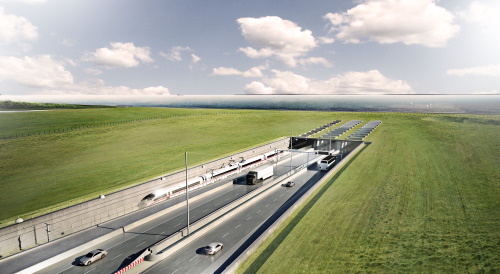Tunnels under - and bridges over troubled waters

During the next decade The Femern tunnel between Denmark and Germany will be constructed as one of the largest infra-structure projects in Denmark. Also in Norway some large traffic infra structure project will be built also with assistance from Danish Experts. The background and the latest updated information of all these projects will be presented at this event
Programme
16:00 - 16:05 Introduction by Hans Otto Holmegaard Kristensen. Owner of HOK Marineconsult ApS
16:05 – 16:50 Construction of the coming Fehmarn Belt Tunnel by Claus Iversen, construction manager, Fehmarn Belt A/S
Abstract: The presentation will include some general background information leading to the construction of the 18 km long Fehmarnbelt Immersed Tunnel between Denmark and Germany, but will focus on the actual construction methods to be used during the works – casting of the tunnel elements in a temporary factory and work harbour just east of Rødbyhavn, dredging of the tunnel trench together with the reclamation of new land at Lolland and the immersion of tunnel elements. Finally an overview of the ship traffic environment in Fehmarnbelt to be planned for as well will be given together with the various navigational safety measures to be implemented to safeguard the navigational safety during the construction works.
Abstract: The presentation will include some general background information leading to the construction of the 18 km long Fehmarnbelt Immersed Tunnel between Denmark and Germany, but will focus on the actual construction methods to be used during the works – casting of the tunnel elements in a temporary factory and work harbour just east of Rødbyhavn, dredging of the tunnel trench together with the reclamation of new land at Lolland and the immersion of tunnel elements. Finally an overview of the ship traffic environment in Fehmarnbelt to be planned for as well will be given together with the various navigational safety measures to be implemented to safeguard the navigational safety during the construction works.
16:55 - 17:40 Free Flow – Efficiency of a One-way traffic lane by Finn Mølsted Rasmussen, Senior Project Manager, Rambøll
Abstract: Ships navigate freely when in open sea, but the freedom of movement is reduced in areas with intense traffic, restricted draught, obstacles or construction activities. In such cases, marked work areas or a traffic separation scheme (TSS) can be established to guide the ship traffic. The presentation is based on early work performed in connection with the studies of a bridge across Fehmarnbelt, and the purpose is to estimate the efficiency of a TSS guiding the ship traffic through the main bridge openings. The efficiency in terms of getting the traffic through the TSS without the TSS being a hindering of the ship traffic flow is an important decision parameter in the bridge design process. We present a new "free flow" paradigm based on an innovative, dynamic application of the ship domain theory. The “free flow” paradigm is applied when planning the construction phase for the tunnel across Fehmarnbelt to demonstrate that the distance between marked work areas, in all construction phases, is appropriate to ensure efficient ship traffic flow.
17:40 - 18:10 Refreshments
18:10 - 18:50 Unconventional floating bridge crossings by Preben Terndrup Petersen, professor emeritus, MEK – DTU
Abstract: The presentation will give an overview of alternative floating bridge designs developed by The Norwegian Public Roads Administration for replacing ferries crossing eight deep (500 – 1000 m) and wide (5 – 6 km) fjords on the Coastal Highway Route E39 in the western part of Norway. Three different concepts will be presented: a) A curved end anchored floating bridge and a straight side anchored floating bridge, b) A floating suspension bridge with pylons supported by Tension Leg Platforms (TLP), and c) Submerged tunnel bridges stabilized twenty to thirty meters below the surface by tethers fixed at the sea bottom or by floaters at the surface. The characteristic response due to environmental and accidental loads will be described. Because any of these floating bridge concepts will involve extrapolation beyond the current experience in bridge design, a discussion of some of the design challenges and validation issues will be presented.
18:50 - 19:30 Navigational simulation studies for large bridge crossings by Jens Bay, FORCE Technology
Abstract: The presentation will give an overview of navigational simulation studies done for the Great Belt bridge, the Oresund bridge, the new Storstrøm bridge as well as pre-studies of a possible Femern bridge. A presentation of the evolution of marine simulations over the last 30 years focusing on determining the necessary bridge spans and fairway designs to ensure safe and efficient marine traffic will be given.
_____
Please remember to unregister if you change your mind. Otherwise there will be a no-show fee of 200 DKK.